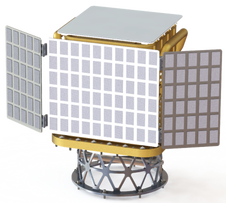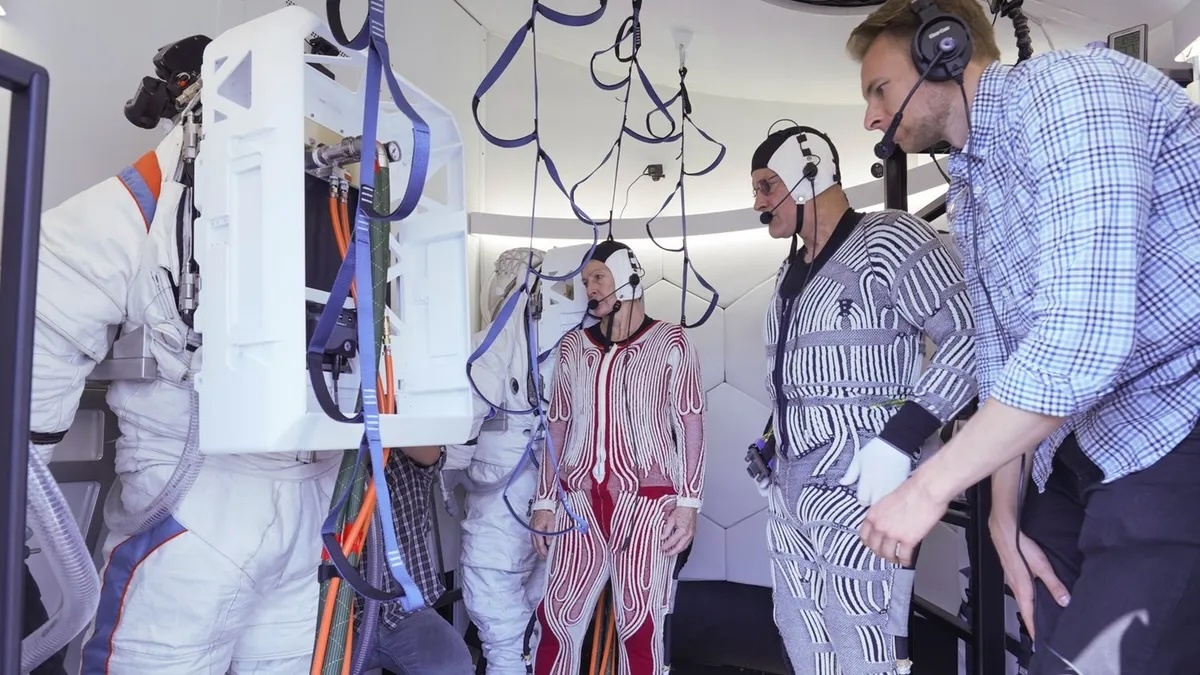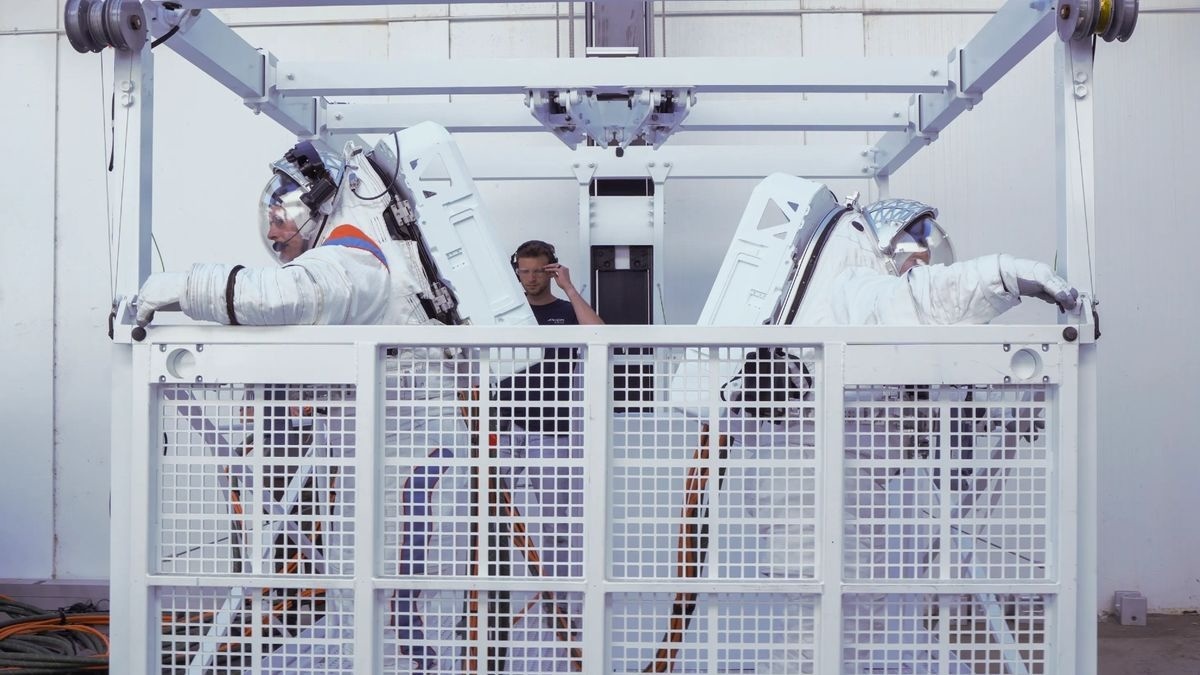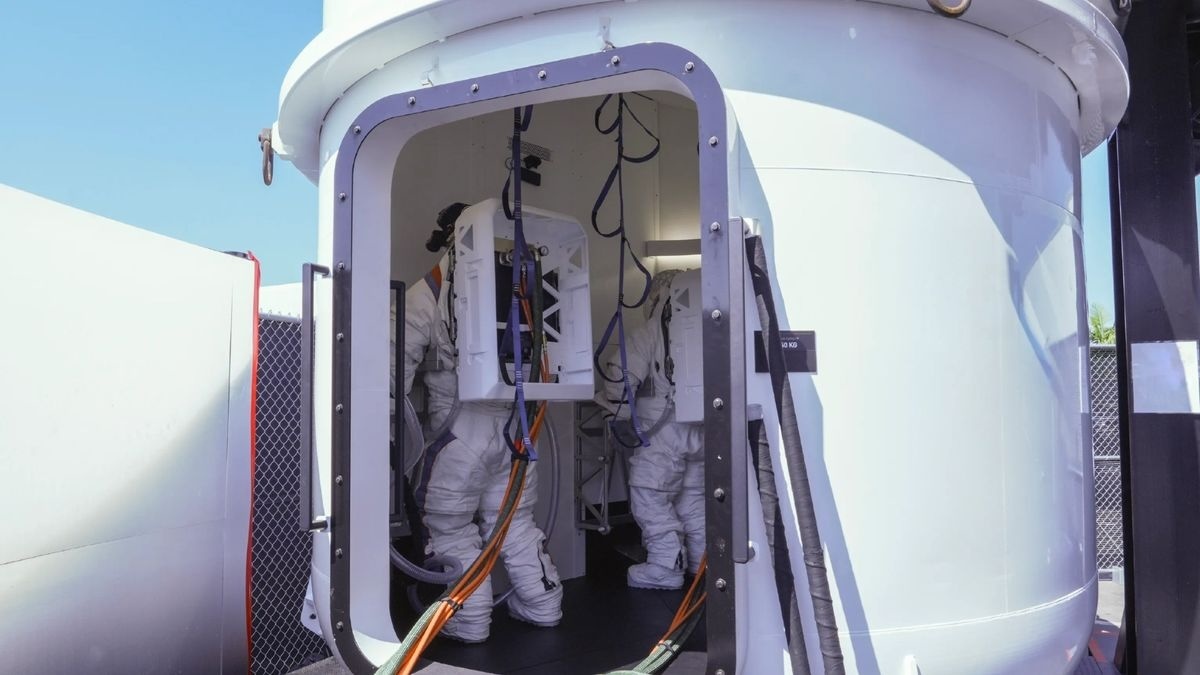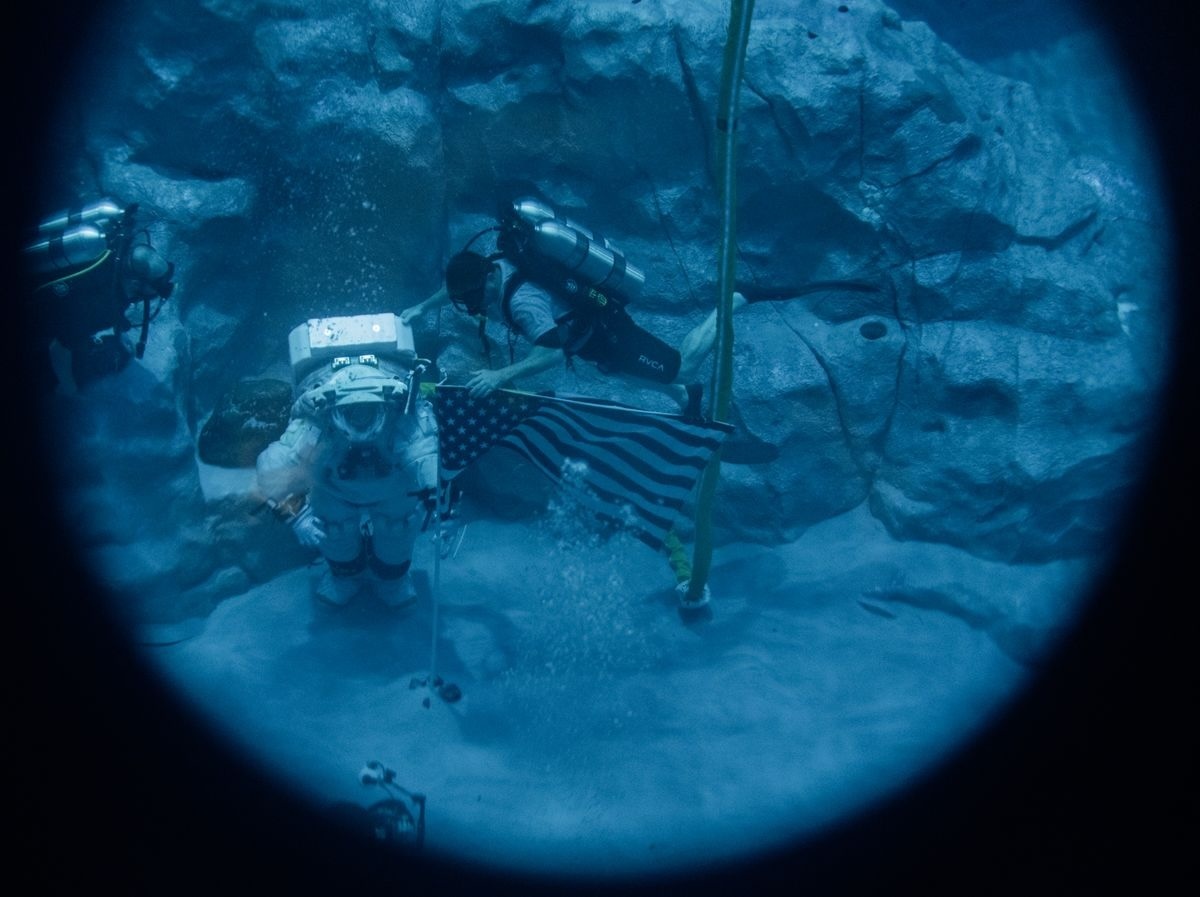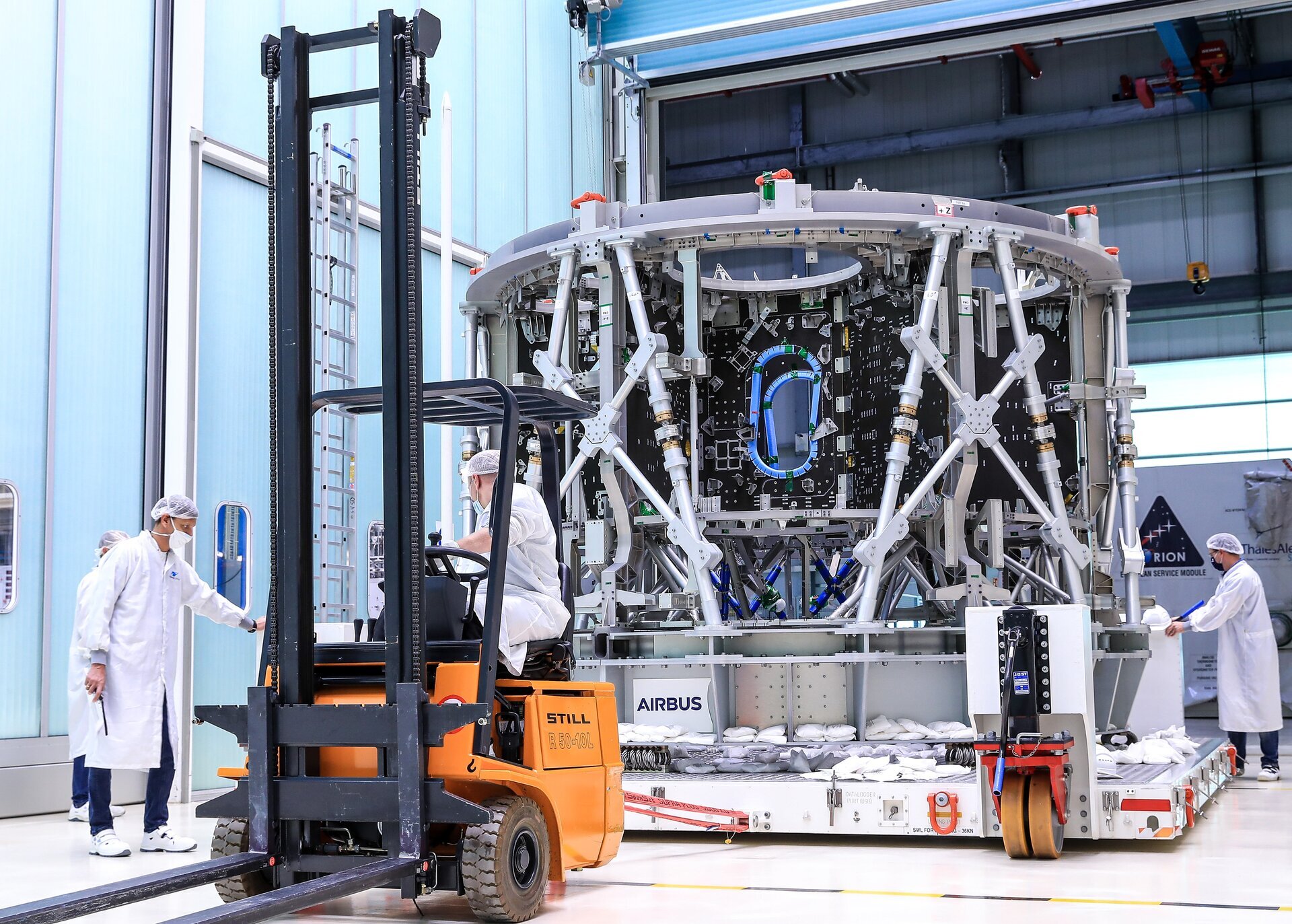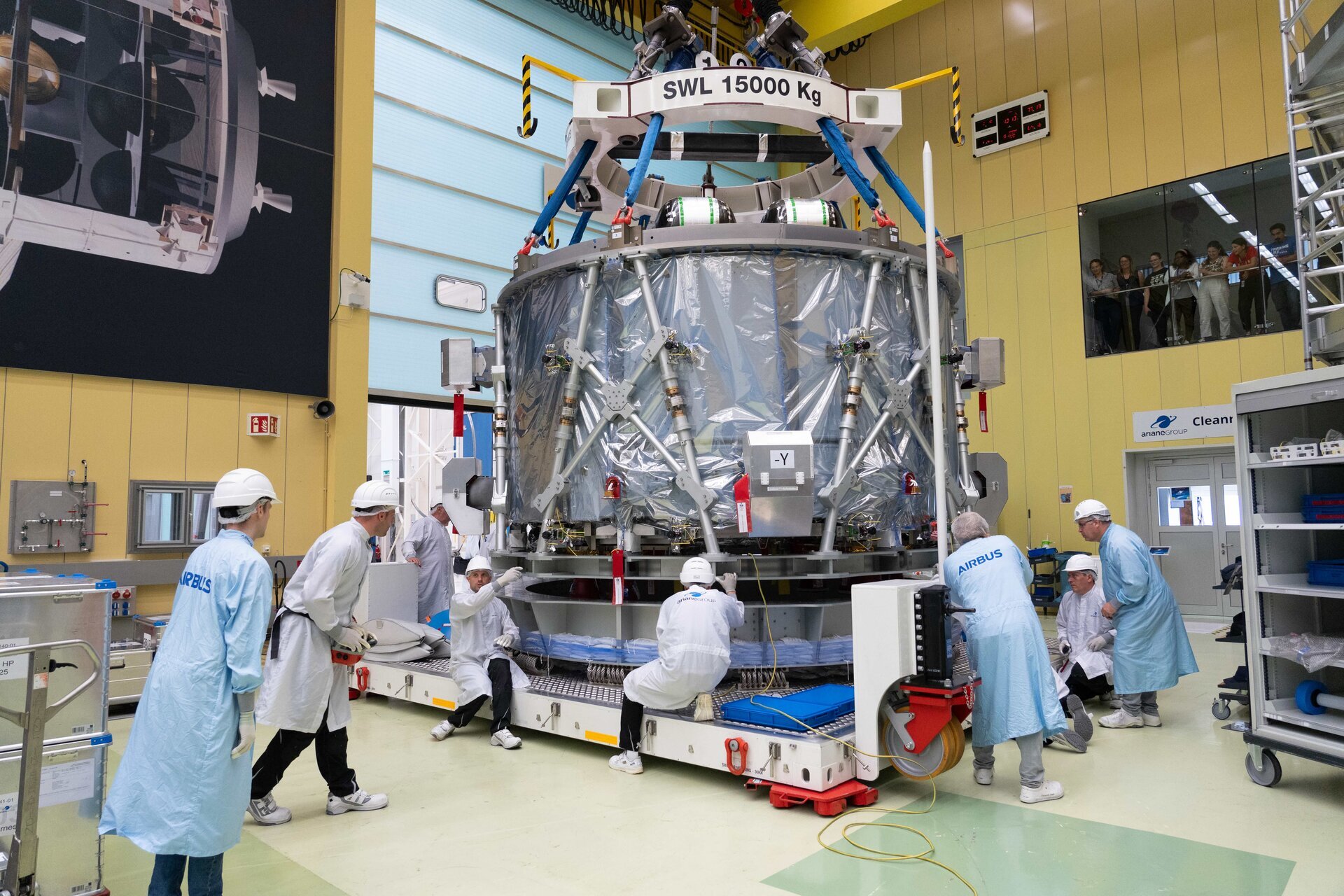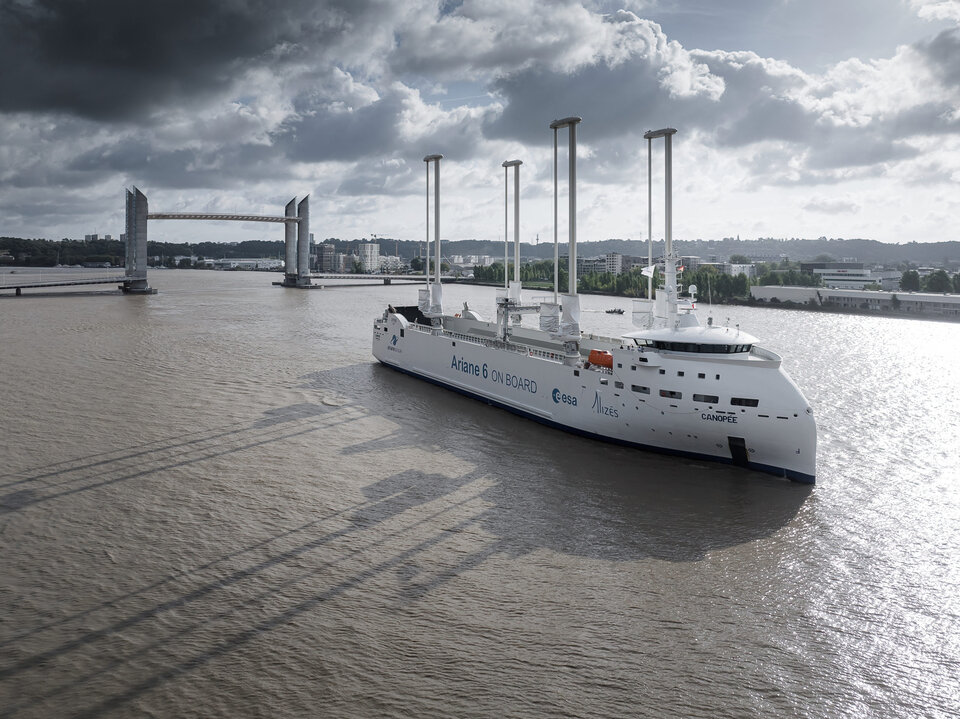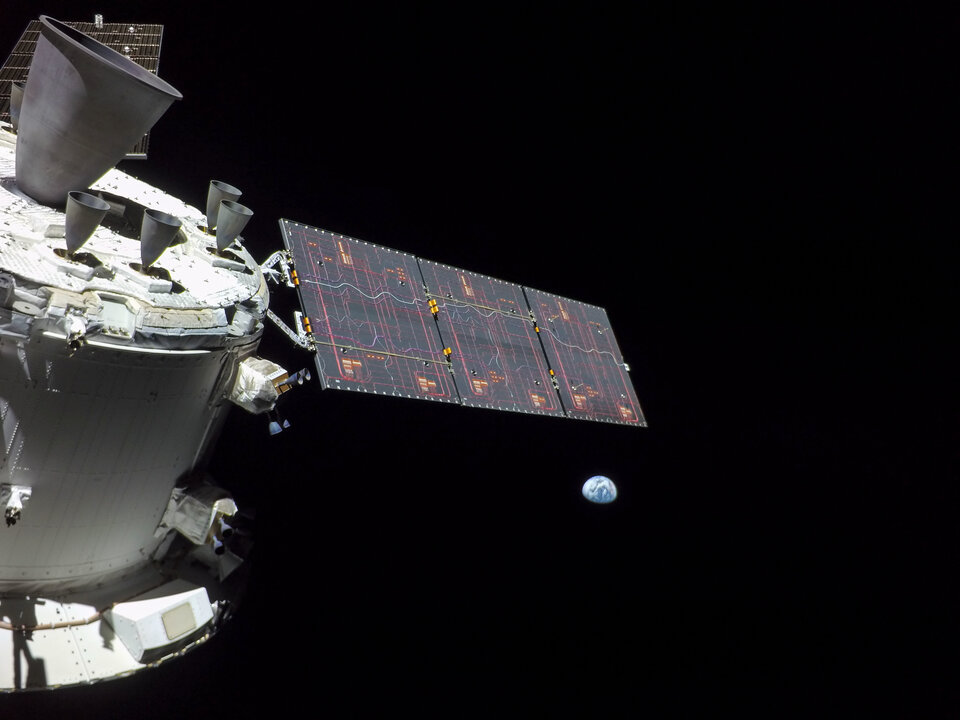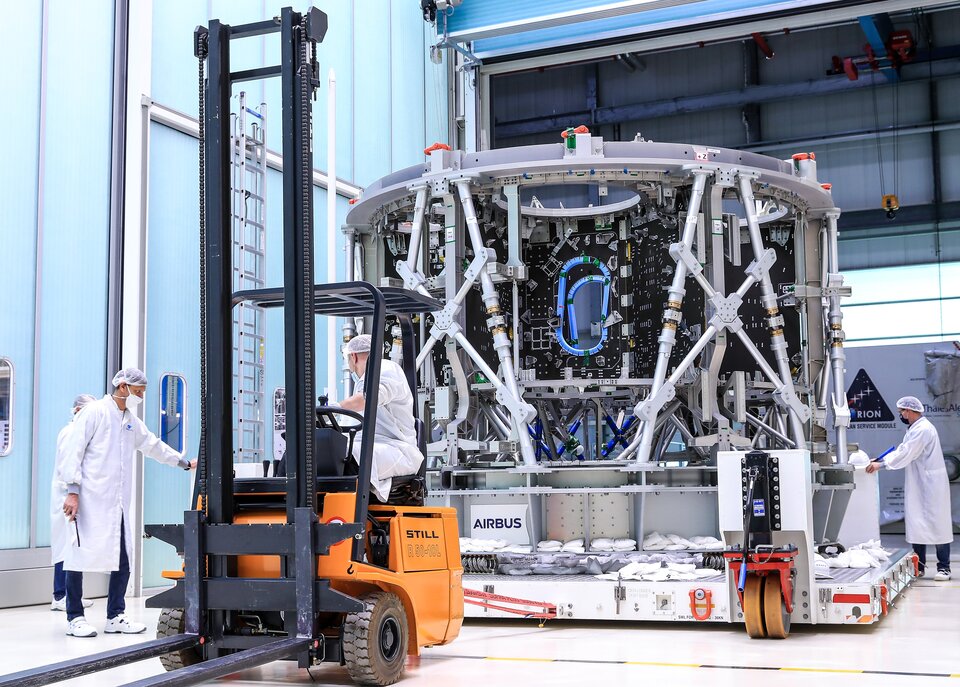Once the European Service Module arrives at NASA’s Kennedy Space Center, engineers will connect it to the Crew Module Adapter and later to the Crew Module itself, with plenty of testing before, in between and after to get the spacecraft ready ahead of the Artemis III mission.
'For the Artemis 3 mission, we will be able to reach astronauts up to 2 kilometers away from the lander.'
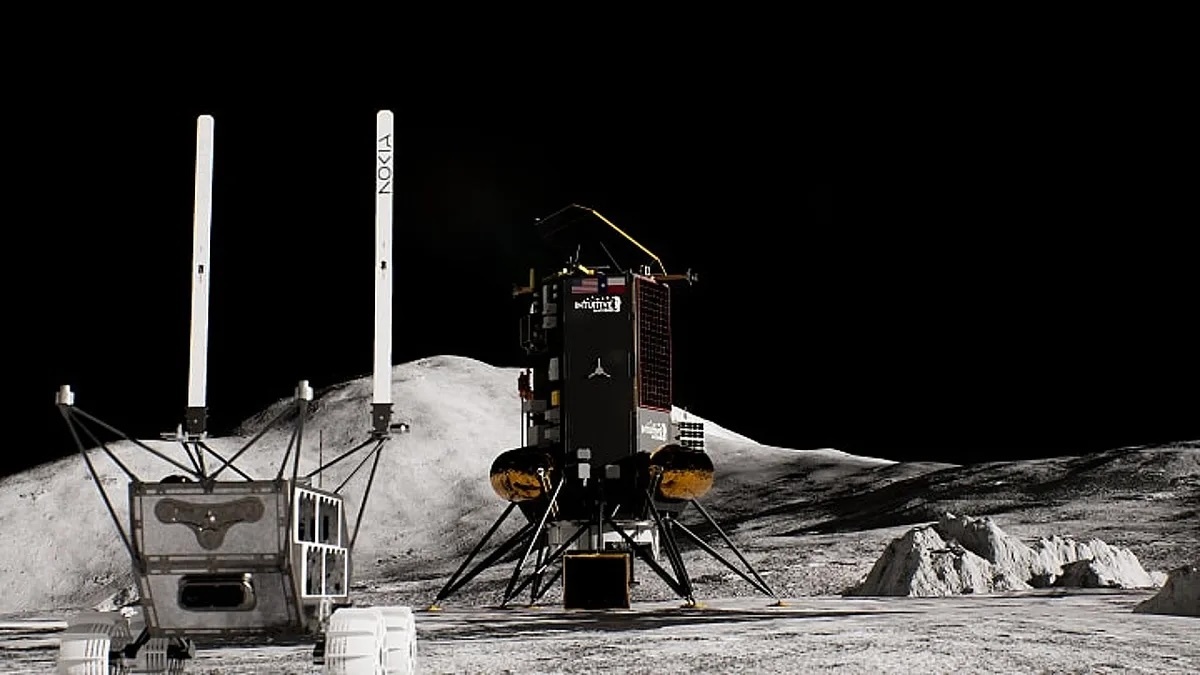
Artist rendering of the Lunar Outpost Mobile Autonomous Prospecting Platform (MAPP) rover with Nokia antennas extended. The images, data and telemetry collected by MAPP will be sent back to the Nova-C lander over the Nokia 4G/LTE network and then relayed to Earth. (Image credit: Nokia/Intuitive Machines)
When NASA's Artemis 3 crewed mission lands on the lunar surface a few years from now, the first astronauts to walk on the moon since the Apollo age will be able to take advantage of something their antecedents could not: cellular network technology.
Artemis 3's astronauts will wear spacesuits equipped with 4G connectivity — the same 4G that makes up the majority of Earth's mobile phone networks today. The spacesuits, Axiom Space's AxEMU models, will be able to connect to a 4G network designed by Nokia. Astronauts can use the network to perform feats like broadcasting high-definition video.
On Earth, a mobile network consists of a grid of base stations — the towers that dot the 21st century's landscape — equipped with a radio array. A wholesale mobile tower is obviously a bit difficult to carry to the moon, so Nokia's design compresses all of a tower's base station equipment into a box that can fit onto a lunar lander.
"For the Artemis 3 mission, we will be able to reach astronauts up to 2 kilometers [1.25 miles] away from the lander," Thierry E. Klein, president of Nokia Bell Labs Solutions Research, told Space.com.
The AxEMU spacesuits, then, will be able to connect to the base station. They won't have a smartphone's touchscreen or interface, but they will be able to stream high-definition video or transmit large volumes of scientific data back to the base station — and, then, by extension, back to Earth.
"From a communication perspective, the key components of a smartphone will be integrated with the spacesuit and adapted to the space environment and operational requirements," Russell Ralston, executive vice president of extravehicular activity at Axiom Space, told Space.com.
Traditionally, crewed missions have relied on ultra-high frequency (UHF) radio for communications. UHF has worked well, but 4G comes with higher bandwidth and faster speeds. Hence, Nokia has been developing the technology for space applications for some years now, helped by a $14.1 million NASA grant in 2020.
The planned lunar 4G network, known as the Lunar Surface Communications System (LSCS), will undergo its first test later this year, when Intuitive Machines' robotic IM-2 mission lands near the lunar south pole. IM-2's lander will carry the base station, while two of IM-2's payloads — the Mobile Autonomous Prospecting Platform (MAPP) rover and the Micro-Nova drone — will carry 4G receivers.
Indeed, Nokia imagines that 4G connectivity could benefit future missions beyond Artemis 3's astronauts and their successors. Astronaut vehicles like the Lunar Terrain Vehicle might also have 4G connectivity. Smaller devices could also connect to the network — Nokia pictures 4G receivers fitting into science experiments or lunar sensors. In the future, a crewed lunar lander could serve as a central hub binding together a web of smaller devices, linking them directly to Earth.
More immediately, Artemis 3 is the goal. Over the remainder of 2024 and into 2025, the 4G-equipped suit will undergo a series of tests — including in vacuum chambers and in the indoor pool at NASA's Johnson Space Center in Houston — to ensure that both the suit and its components hold up in the extreme conditions to which it will be exposed during life on the moon.
Quelle: Space.com
----
Update: 7.09.2024
.
New Hardware for Future Artemis Moon Missions Arrive at NASA Kennedy
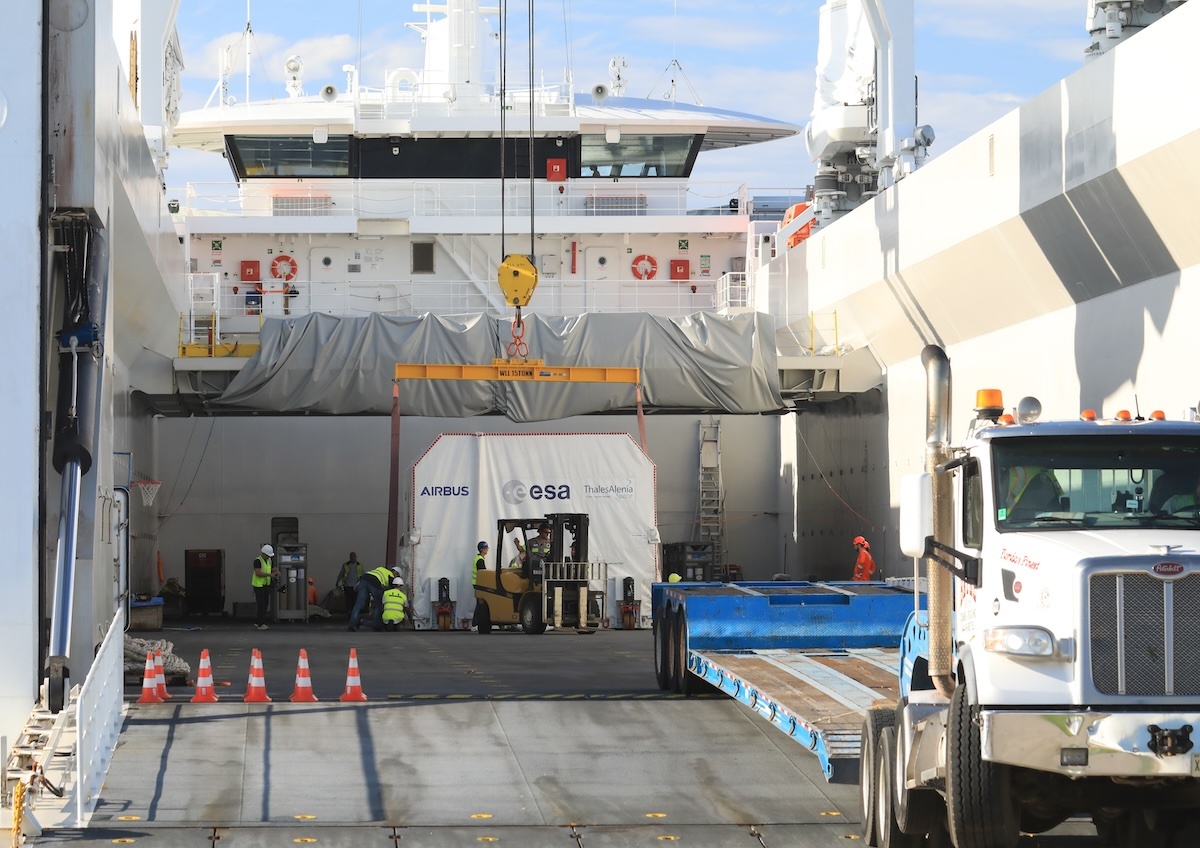
On the left, the Canopee transport carrier containing the European Service Module for NASA’s Artemis III mission arrives at Port Canaveral in Florida, on Tuesday, Sept. 3, 2024, before completing the last leg of its journey to the agency’s Kennedy Space Center’s Neil A. Armstrong Operations and Checkout via truck. On the right, NASA’s Pegasus barge, carrying several pieces of hardware for Artemis II, III, and IV arrives at NASA Kennedy’s Launch Complex 39 turn basin wharf on Thursday, Sept. 5, 2024. Credit: NASA
From across the Atlantic Ocean and through the Gulf of Mexico, two ships converged, delivering key spacecraft and rocket components of NASA’s Artemis campaign to the agency’s Kennedy Space Center in Florida.
On Sept. 3, ESA (European Space Agency) marked a milestone in the Artemis III mission as its European-built service module for NASA’s Orion spacecraft completed a transatlantic journey from Bremen, Germany, to Port Canaveral, Florida, where technicians moved it to nearby NASA Kennedy. Transported aboard the Canopée cargo ship, the European Service Module—assembled by Airbus with components from 10 European countries and the U.S.—provides propulsion, thermal control, electrical power, and water and oxygen for its crews.
“Seeing multi-mission hardware arrive at the same time demonstrates the progress we are making on our Artemis missions,” said Amit Kshatriya, deputy associate administrator, Moon to Mars Program, at NASA Headquarters in Washington. “We are going to the Moon together with our industry and international partners and we are manufacturing, assembling, building, and integrating elements for Artemis flights.”
NASA’s Pegasus barge, the agency’s waterway workhorse for transporting large hardware by sea, ferried multi-mission hardware for the agency’s SLS (Space Launch System) rocket, the Artemis II launch vehicle stage adapter, the “boat-tail” of the core stage for Artemis III, the core stage engine section for Artemis IV, along with ground support equipment needed to move and assemble the large components. The barge pulled into NASA Kennedy’s Launch Complex 39B Turn Basin Thursday.
The spacecraft factory inside NASA Kennedy’s Neil Armstrong Operations and Checkout Building is set to buzz with additional activity in the coming months. With the Artemis II Orion crew and service modules stacked together and undergoing testing, and engineers outfitting the Artemis III and IV crew modules, engineers soon will connect the newly arrived European Service Module to the crew module adapter, which houses electronic equipment for communications, power, and control, and includes an umbilical connector that bridges the electrical, data, and fluid systems between the crew and service modules.
The SLS rocket’s cone-shaped launch vehicle stage adapter connects the core stage to the upper stage and protects the rocket’s flight computers, avionics, and electrical devices in the upper stage system during launch and ascent. The adapter will be taken to Kennedy’s Vehicle Assembly Building in preparation for Artemis II rocket stacking operations.
The boat-tail, which will be used during the assembly of the SLS core stage for Artemis III, is a fairing-like structure that protects the bottom end of the core stage and RS-25 engines. This hardware, picked up at NASA’s Michoud Assembly Facility in New Orleans, will join the Artemis III core stage engine section housed in the spaceport’s Space Systems Processing Facility.
The Artemis IV SLS core stage engine section arrived from NASA Michoud and also will transfer to the center’s processing facility ahead of final assembly.
Under the Artemis campaign, NASA will land the first woman, first person of color, and its first international partner astronaut on the lunar surface, establishing long-term exploration for scientific discovery and preparing for human missions to Mars. The agency’s SLS rocket and Orion spacecraft, and supporting ground systems, along with the human landing system, next-generation spacesuits and rovers, and Gateway, serve as NASA’s foundation for deep space exploration.
Quelle: NASA
----
Update: 30.10.2024
.
NASA Provides Update on Artemis III Moon Landing Regions
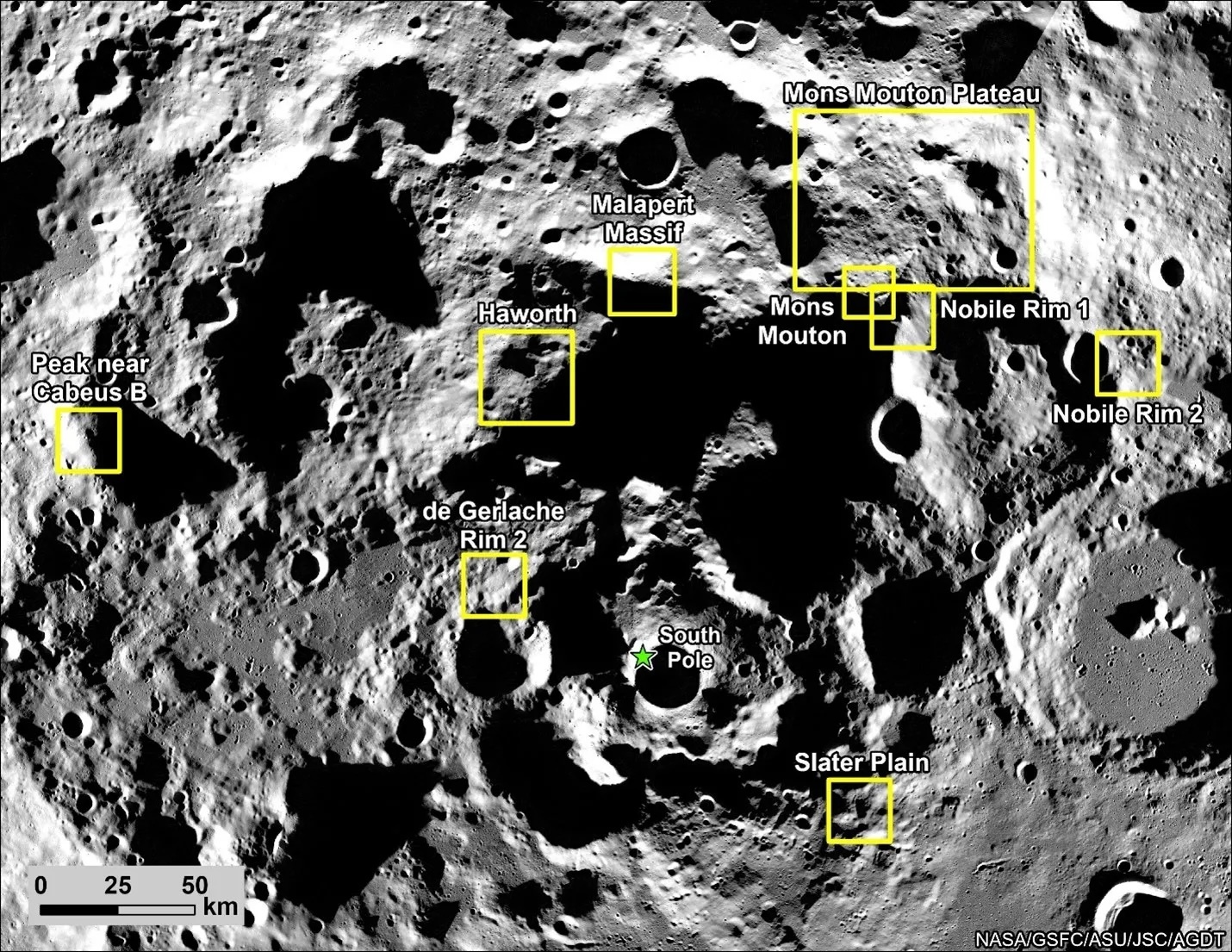
This image shows nine candidate landing regions for NASA’s Artemis III mission, with each region containing multiple potential sites for the first crewed landing on the Moon in more than 50 years. The background image of the lunar South Pole terrain within the nine regions is a mosaic of LRO (Lunar Reconnaissance Orbiter) WAC (Wide Angle Camera) images.
Credit: NASA
As NASA prepares for the first crewed Moon landing in more than five decades, the agency has identified an updated set of nine potential landing regions near the lunar South Pole for its Artemis III mission. These areas will be further investigated through scientific and engineering study. NASA will continue to survey potential areas for missions following Artemis III, including areas beyond these nine regions.
“Artemis will return humanity to the Moon and visit unexplored areas. NASA’s selection of these regions shows our commitment to landing crew safely near the lunar South Pole, where they will help uncover new scientific discoveries and learn to live on the lunar surface,” said Lakiesha Hawkins, assistant deputy associate administrator, Moon to Mars Program Office.
NASA’s Cross Agency Site Selection Analysis team, working closely with science and industry partners, added, and excluded potential landing regions, which were assessed for their science value and mission availability.
The refined candidate Artemis III lunar landing regions are, in no priority order:
- Peak near Cabeus B
- Haworth
- Malapert Massif
- Mons Mouton Plateau
- Mons Mouton
- Nobile Rim 1
- Nobile Rim 2
- de Gerlache Rim 2
- Slater Plain
These regions contain diverse geological characteristics and offer flexibility for mission availability. The lunar South Pole has never been explored by a crewed mission and contains permanently shadowed areas that can preserve resources, including water.
“The Moon’s South Pole is a completely different environment than where we landed during the Apollo missions,” said Sarah Noble, Artemis lunar science lead at NASA Headquarters in Washington. “It offers access to some of the Moon’s oldest terrain, as well as cold, shadowed regions that may contain water and other compounds. Any of these landing regions will enable us to do amazing science and make new discoveries.”
To select these landing regions, a multidisciplinary team of scientists and engineers analyzed the lunar South Pole region using data from NASA’s Lunar Reconnaissance Orbiter and a vast body of lunar science research. Factors in the selection process included science potential, launch window availability, terrain suitability, communication capabilities with Earth, and lighting conditions. Additionally, the team assessed the combined trajectory capabilities of NASA’s SLS (Space Launch System) rocket, the Orion spacecraft, and Starship HLS (Human Landing System) to ensure safe and accessible landing sites.
The Artemis III geology team evaluated the landing regions for their scientific promise. Sites within each of the nine identified regions have the potential to provide key new insights into our understanding of rocky planets, lunar resources, and the history of our solar system.
“Artemis III will be the first time that astronauts will land in the south polar region of the Moon. They will be flying on a new lander into a terrain that is unique from our past Apollo experience,” said Jacob Bleacher, NASA’s chief exploration scientist. “Finding the right locations for this historic moment begins with identifying safe places for this first landing, and then trying to match that with opportunities for science from this new place on the Moon.”
NASA’s site assessment team will engage the lunar science community through conferences and workshops to gather data, build geologic maps, and assess the regional geology of eventual landing sites. The team also will continue surveying the entire lunar South Pole region for science value and mission availability for future Artemis missions. This will include planning for expanded science opportunities during Artemis IV, and suitability for the LTV (Lunar Terrain Vehicle) as part of Artemis V.
The agency will select sites within regions for Artemis III after it identifies the mission’s target launch dates, which dictate transfer trajectories, or orbital paths, and surface environment conditions.
Under NASA’s Artemis campaign, the agency will establish the foundation for long-term scientific exploration at the Moon, land the first woman, first person of color, and its first international partner astronaut on the lunar surface, and prepare for human expeditions to Mars for the benefit of all.
Quelle: NASA
----
Update: 7.12.2024
.
"Space is hard:" NASA pushes back target dates for Artemis return to the moon launches
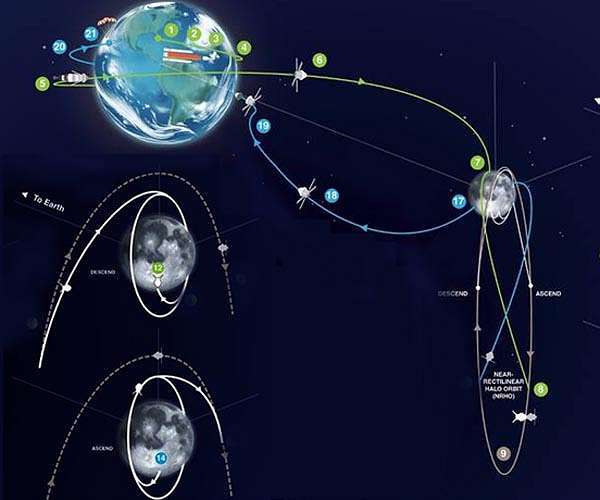
NASA's Artemis II mission, aimed at sending humans around the moon for the first time in more than 50 years, has once again been delayed.
Artemis II has been pushed from a target of late next year to April 2026, while Artemis III, which will land humans on the moon, is postponed until mid-2027. The announced delays came after a NASA administration meeting Thursday.
NASA said it needs time to ensure all the issues observed with the Orion spacecraft are corrected for the safety of the astronauts.
In announcing the decision, NASA Administrator Bill Nelson recalled President Kennedy's famous "We choose to go to the moon" speech.
"Space is hard," said Nelson. "And the endeavor like Artemis over a half a century after Apollo is hard. It's the pinnacle of new possibilities. It's the most daring, technologically challenging, collaborative, international endeavor that humanity has ever set out to do. And the Artemis I test flight was just that. It was a flight test on a new spacecraft and new technology.'
Artemis I launched in 2022. The spacecraft's heat shield preformed in unexpected ways, including showing erosion upon reentry. During reentry, the spacecraft preformed a skip reentry, in which it dips in and out of atmosphere. What was found to have happened was heat accumulated in the heat shield's outer layer, which led to the trapping of gasses and cracking.
NASA has since done extensive testing on the heat shield and come up with a plan forward. The plan includes keeping the current Orion spacecraft design and modifying the reentry trajectory, lowering the heat inflicted on the spacecraft.
Orion also saw an issue with environmental controls during that first flight. The environmental control and life support system, known as the ECLSS, needs work to make sure it functions as needed. Issues were also found with the electrical system in an abort scenario.
Nelson emphasized that the safety of astronauts is NASA's "North Star." They simply will not fly until the agency is confident in the performance of the Orion spacecraft.
When is the next Florida rocket launch? Is there a launch today? Upcoming SpaceX, NASA rocket launch schedule from Florida
Artemis III, which will return humans to the moon, is now scheduled for mid-2027. Nelson noted that this is well ahead of the Chinese government's planned landing in 2030. He said it was vital to land on moon's south pole ahead of the Chinese.
"We need our commercial and international partners to double down to meet and improve this schedule," said Nelson, explaining he has met with SpaceX and Blue Origin who will provide human landers for the program. He also mentioned meeting with Axiom, which is developing the spacesuits to be worn on the lunar surface, as well as the European Space Agency which is providing the Orion spacecraft service module. That's the lower part of the spacecraft containing propulsion, power and life support systems. Lockheed Martin, which is developing the Orion spacecraft, is also involved.
Currently, at Kennedy Space Center, the SLS (Space Launch System) rocket for Artemis II is being stacked. The solid rocket boosters are being prepared, and soon NASA expects the stacking of the core stage, which arrived at the giant Vehicle Assembly Building in late July.
Artemis II astronaut speaks on launch move, SpaceX Starship
"We really appreciate the willingness to take the risk, to actually slow down and understand root cause, determine the path forward, corrective action for Artemis II and Artemis III," said Reid Wiseman, Artemis II commander. "So that when Victor, Christina, Jeremy and I launch and land after a successful Artemis II, we will look to Artemis III to carry the torch forward and to put humans back on the moon."
Wiseman recalled that he and his Artemis II crewmates were in Florida seeing the rocket and spacecraft on November 19 when SpaceX's Starship Flight 6 happened in SpaceX's Texas spaceport. The crew watched it unfold on Artemis II crew member Jeremy Hansen's phone in Orlando airport. Artemis III is slated to use the Starship human lander.
"And it was in that moment for me, as a kid who was born after Apollo − that moment in the Orlando airport. I had just seen our booster. I had just seen the Orion spacecraft. I'm now watching the Starship sixth test flight," said Wiseman. "All the elements are there for humans on the moon, and all the elements are there to push us onto Mars in the very... near future. And I just I felt it in my soul. I felt it and I believed it."
Meanwhile, Nelson was asked about President-elect Trump's decision to nominate billionaire spaceman Jared Isaacman as the next NASA administration. Nelson said he spoke with Isaacman Wednesday and invited him to meetings. Since news on Artemis was breaking, he said he had not had time to tell him the latest developments.
"I think it will be received very well by the new reign," said Nelson on the current plan forward for Artemis.
Quelle: Florida Today
